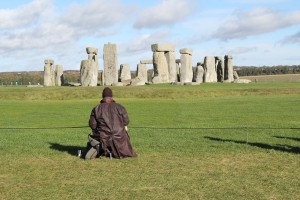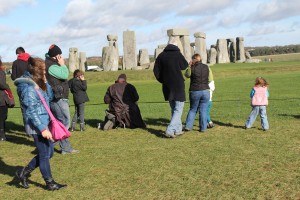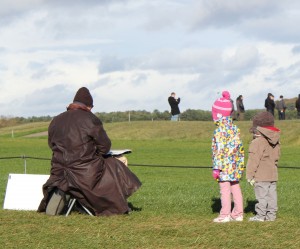Stonehenge – Friday 2nd November
Over the summer months we’ve regularly seen certain vehicles parked up along the byway at Stonehenge, especially at the weekends. One, a bright yellow bus, is accompanied by a large, square, blue tent housing a full drum kit. I didn’t expect to see it in November, but it’s here. The drummer is having a great time. The extended solo pounds across the plain. It greets you in the car park and carries all the way up to the monument field. The Stonehenge Drummer.
It’s bitterly cold in the wind but the light on the Stone Circle is fabulous. I get onto the tarmac walkway and hear, “Twenty one Russians on their way up!” over the staff walkie-talkies.
Mark sets up and sits by the guide rope on the widest part of the grass walkway. He’s started a series of studies in his studio and is being really specific now about visual information gathering. Details.
I’m sitting on a bench and a Russian family arrives, the father going to the other end of the wooden seat. He sets up a small compact camera on a miniature tripod and beckons his family forward and into place. He sets the timer and sprints to join the line-up. The camera emits a series of gradually accelerating beeps before it makes the final loud digital shutter noise. Everyone holds their positions and the father repeats the ritual, just in case.
There are a lot of families visiting today. I hear Russian, Italian, Spanish and English in the space of a minute. The children are bold when it comes to looking at Mark drawing. They’re properly interested and I think they open the way for certain adults to stand and stare in a way they might be too shy to do if they didn’t have the cover of the kids. The usual photos are taken, but the mad crowds of summer are gone and Mark is largely left to get on.
I hear another drum, the sound of a stick on skin. A Bodhran type noise. A man stands in front of a camera, Stonehenge as his background and does a short burst of rhythm. The camera is reset on its tall tripod legs and he returns to his spot, this time with a small child clinging to his chest. He beats his drum and does a couple of bars of singing, “Hey-ah hey-ah hey-ah hah. Hey-ah hey-ah hey-ah hah.” And then he’s done. He heads towards me on the bench with his family group and they settle on the end and on the grass to make some more music. A couple of palm sized open silver bells appear and they ring out with a fine resonant tone. A young woman with a clear sweet voice starts to sing, “Forest, Mountain, River, Listen to my sound.”
Visitors are drawn to the singing and start to take photos of the family. Some Japanese women spot them and wave excitedly at their toddler. Their excitement builds as the man takes over the singing and beats his drum. The women crouch next to the family on the grass and their friends take photos of them. Other people gather round, cameras clicking as the man with the drum keeps the rhythm going, singing loudly and clearly. It’s all fantastically celebratory.
As the Japanese visitors walk away, the little boy in the family laughs and says, “Why do they want to take photos of us? They were all taking photos of us”, and everyone laughs.
“Beautiful. I love it,” says the man.
He offers the Japanese visitors a CD. “Here. Here’s a gift for you”, he says. “We’re going round the country making music, and this is for you.” The women are unbelievably delighted.
Some-days I really love this place.
As the group gather their belongings we speak and I meet Giles and Juliette Bryant and their lovely family who are doing their own project in music called The Perpetual Choirs. They also give me a gift of their CD. I don’t know about the perpetual choirs but the CD inner sleeve explains a little about an ancient musical practice centred around the mystical sites of Glastonbury, Stonehenge and Llantwit Major.
Giles writes, “The practice of using sound to heal is a worldwide phenomenon. It seems the ancients understood the power of songs, prayer, dance, meditation and music to benefit themselves and the earth. These practices are returning to the world as people awaken to the healing power of sound”. (www.theperpetualchoirs.com)
I know for sure those Japanese visitors won’t forget their trip to Stonehenge.


